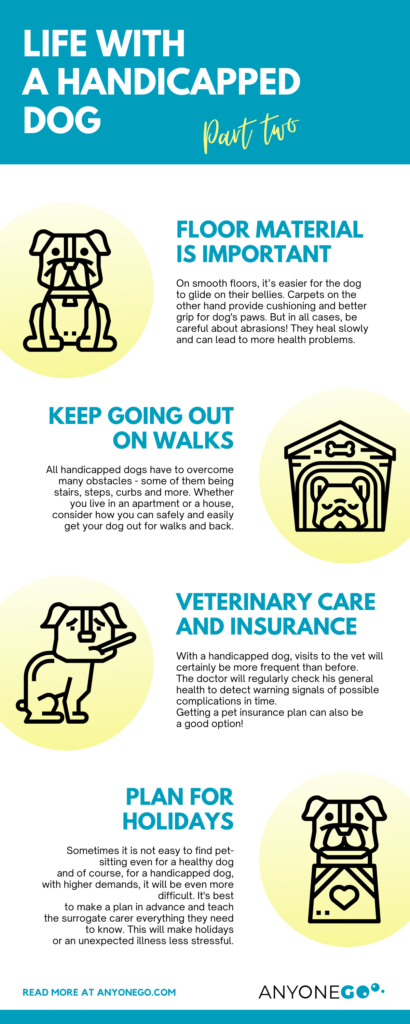Life with a dog in a wheelchair, part 2
The first part of our article was already full of interesting information, but there are still some things we haven´t talked about yet.
So let´s look at the promised second part.
In addition, we are already working on another similar text for you, where we will focus on the most useful and interesting aids for handicapped dogs.
As soon as the article is published, we will let you know on our social media!
WHAT TO PREPARE FOR WHEN YOUR DOG IS USING A WHEELCHAIR 2
Again – brief overview first

AND NOW MORE IN DETAIL:
Changes in the apartment

If a person needs to use a wheelchair, it usually means significant changes in the apartment. The adjustments to make for a dog in a wheelchair, or even dogs that don’t use the wheelchair at home, are not so extreme, but you still need to think about a few things.
What is the materials of the floors? Wood, PVC, carpet, tiles..?
On smooth floors, dog paws do not have such a firm grip, which makes walking harder. On the other hand, it’s easier for the dog to glide on their bellies, but be careful! Smooth floors such as tiles or PVC tend to be colder and there is a risk that your dog will catch a cold.
Carpets provide a better grip and a warm cushion, but if there is an accident, it is harder to clean. Unlike tiles or other smooth surfaces, you can’t just quickly wipe the carpet.
Also remember that crawling around without the wheelchair can cause abrasions – directly in the most sensitive places and, of course, on the paws. Usually they don’t notice it too much, due to reduced sensitivity, but every abrasion and wound heals very poorly and for a long time and carries with it the risk of infection. Therefore, consider the use of protective equipment such as drag bags or incontinence belts. (We’ll look at them in more detail in a separate article.)
Both smooth floors and carpets have their pros and cons, so we don’t have a clear recommendation for you. Just try what will suit you, your dog and your floors.
How do I get him out?

All handicapped dogs have to overcome many obstacles – some of them being stairs, steps, curbs and more. When working to solve this issue, the dog breed plays a huge role. You can easily grab a dachshund or other similar little one in your arms and carry it anywhere at any time. But what about large breeds? Manipulating a dog that weighs dozens of kilograms is really demanding.
If you live in an apartment, consider whether you can safely and rather easily get your dog out for walks and back. Unfortunately, the wheelchair and stairs are not a good fit and we do not recommend to use the cart in this way – it might hurt the dog and break the wheelchair.
If you live in a house, you can create a safe space for your dog on the ground floor and figure out how to make access to the garden or the street as easy as possible.
Veterinary costs

With a handicapped dog, visits to the vet will certainly be more frequent than before. The doctor will regularly check his general health and some specific areas in order to detect warning signals of possible complications in time.
You will probably not only visit a veterinarian, but also a dog physiotherapist. Depending on the specific situation, you can have prescribed / recommended various rehabilitation exercises that can help you either significantly improve the dog’s health situation or at least maintain the current state and condition of the muscles. For example, massages will help relax those parts of the body that now have to work double due to paralysis.
Compared to operations and other emergency expenses, these are no longer significant costs, but still be prepared for the fact that having a paralyzed dog is more expensive than a healthy one.
Dog insurance

Every owner certainly knows that nowadays there are many possibilities to get pet insurance. We definitely recommend informing yourself about contributions for treatment, rehabilitation or movement aids. Having at least a basic overview pays off especially for owners of dogs who are prone to movement problems – whether they are dachshunds or wolfhounds. (We are also preparing a separate blog post for you on this topic.)
Holidays and other exceptional situations

Are you clear on how your dog will be taken care of if you are not available for some time? Sometimes it is not easy to find “babysitting” even for a healthy dog and of course, for a handicapped dog, with higher demands, it will be even more difficult.
Keep this in mind when planning your life with a handicapped fluffy partner. Definitely try to find and especially “train” the replacement caregiver in time. For example, if you suddenly end up in the hospital or encounter other inconveniences, there will be no time or space for things like learning to empty the bladder or putting on the wheelchair. When you’re ready for all curveballs life can throw at you, you’ll be less worried!
Did we forget something?
The most experienced in the care of paralyzed dogs, are you, the owners of these little heroes. If you think we should add something to this list, let us know. We will be happy to add more information and help other families of newly paralyzed dogs!
